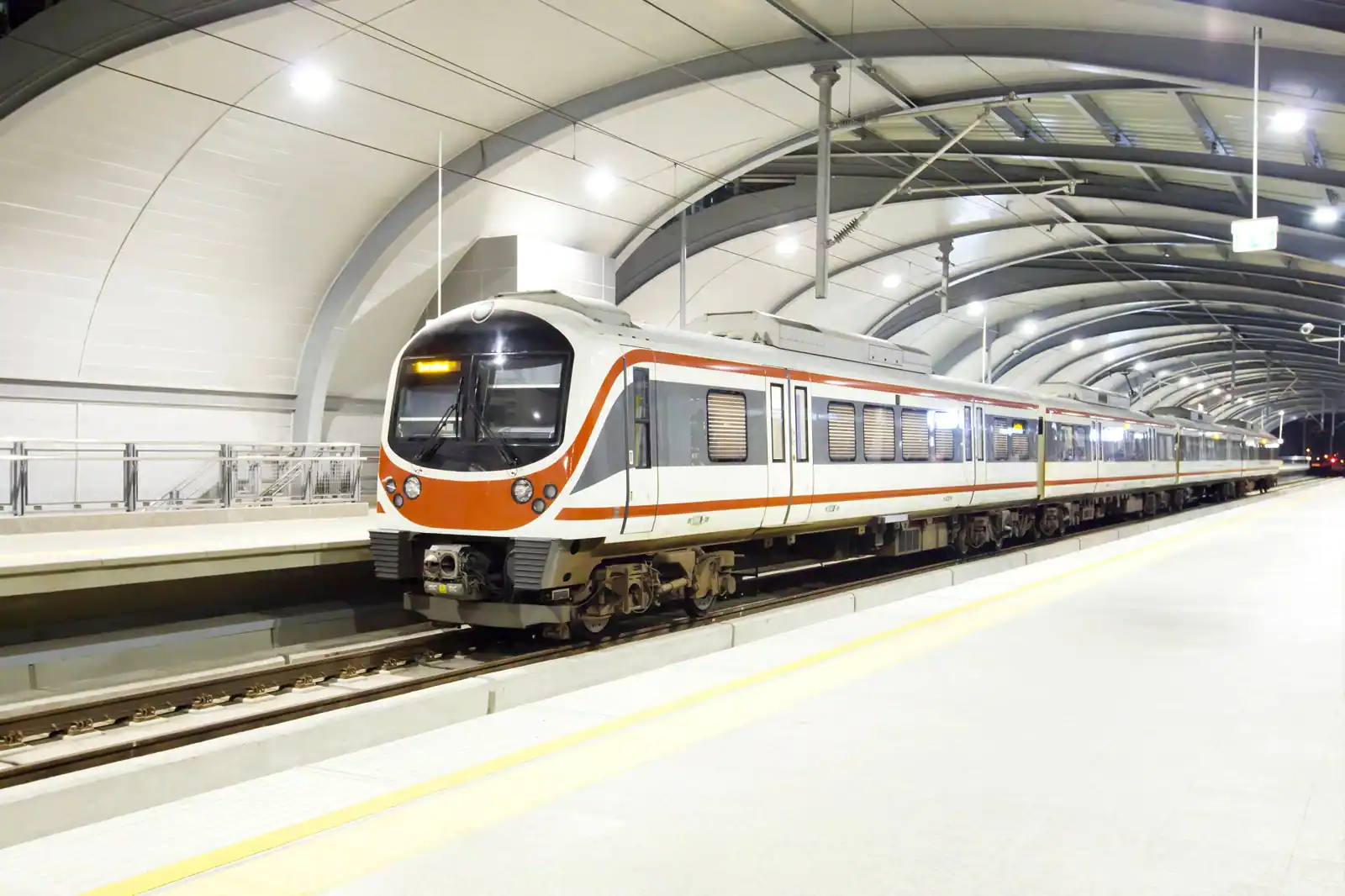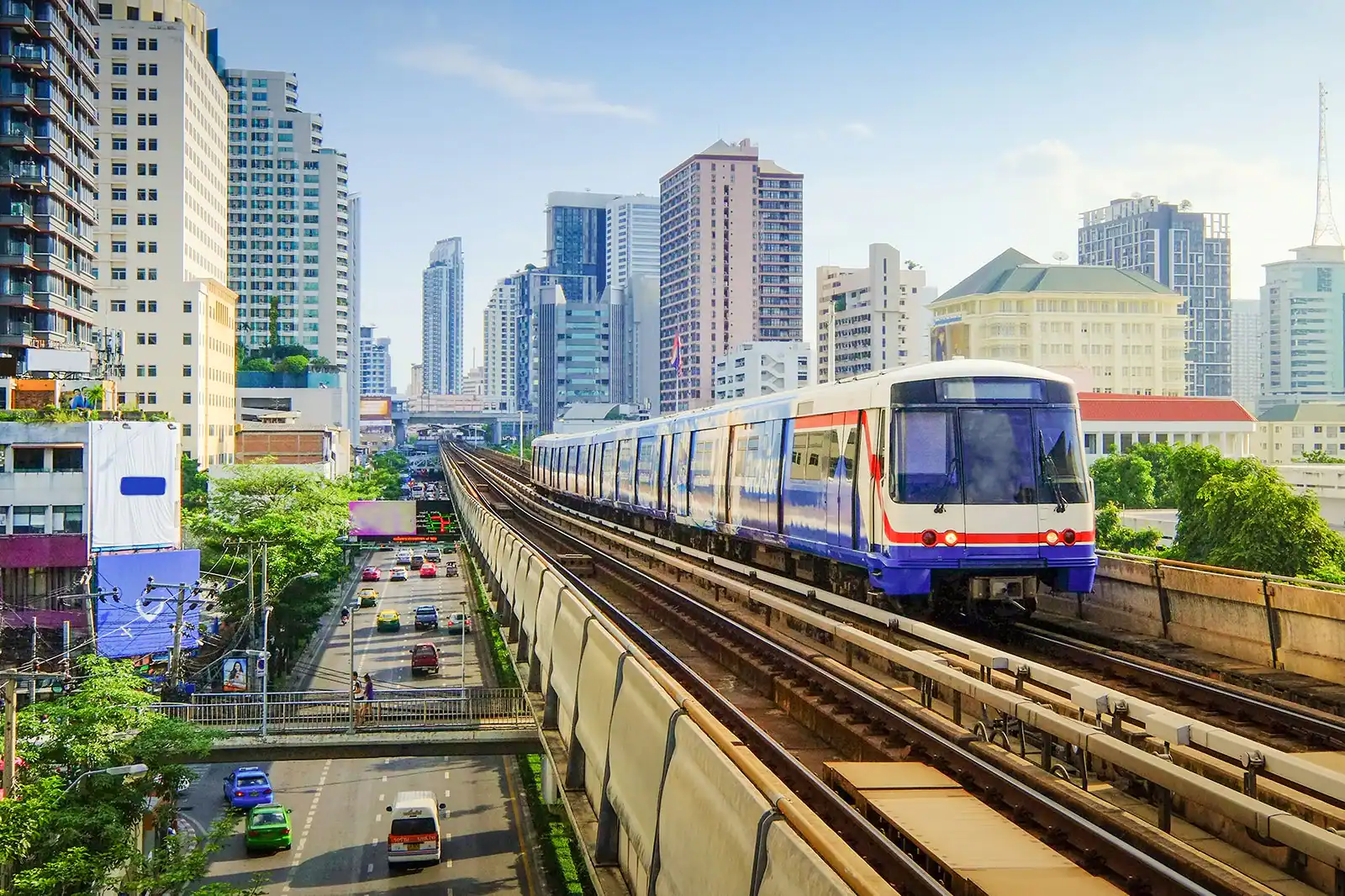
Travel Guides & Information

Hua Lampong Railway Station
Hua Lamphong, or Bangkok Train Station, is the main terminal to northern, eastern, northeastern and southern Thailand. It connects with the MRT underground system and features a distinct half-dome structure, designed by an Italian architect Mario Tamagno in an Italian neo-renaissance style.
Open in 1916, Hua Lamphong boasts an elegant design, similar to several government buildings and public monuments built during the same period, such as the Ananta Samakhom Throne Hall, The Bank of Thailand Museum and Parliament building – all designed by the same architect. Its appearance and interior layout have been compared with the Frankfurt Train Station, which also features the half-dome façade, a giant clock on the front gable and open-air passenger galleries.
Bangkok Train Station has a simple layout. The entrance leads directly to the ticketing and waiting area. On the left-hand side are the 26 ticketing booths and 2 giant English/Thai electronic information display boards featuring real-time departures and arrivals. To the right of the ticketing booths, there’s a waiting area filled with rows of chairs. There are also a handful of fast food outlets and shops on the ground floor as well as on the mezzanine level.
Walk pass the ticketing area and you arrive at the passenger galleries. Non-passengers are allowed to go inside and all the way to the platforms to see the passengers off or alighting from the carriages. Outdoor parking is located to the west of the station, while taxis are parked right in front, to your right as you exit the station.

Ticketing and fares
Train tickets can be purchased on the same day or in advance, and fares vary according to the type of seat and train. Select your seat and train from the plan displayed on the screen. Make sure you don’t make a mistake, as there are no refunds for purchased tickets. You might be able to change seat, train, or departure time – but only once.
E-tickets are also available, but seats are limited. You can only purchase first and second class air-conditioned sleeper tickets:
Types of seats
Before you purchase a train ticket, it’s good to know the difference between the various types of trains and seats available. First-class seats are air-conditioned and can be converted to sleeping berths. The seating arrangement is more private, with up to 24 seats or single-passenger compartments. Second class seats are also air-conditioned (or non-air-conditioned) and some can be converted to sleeping berths; each compartment has from 26 to 40 seats. Third-class seats are either air-conditioned or non-air-conditioned.
Train Types
The types of seats are determined by the types of trains as well. Below are the six types of trains available, from the fastest to slowest.

Bangkok Train Excursions
Apart from the destination trains, the State Railway of Thailand (SRT) operates a handful of 1-day train excursions to major regional attractions, such as Kanchanaburi, Hua Hin, Petchaburi, Damnoen Saduak Floating Market, Cha-Am, and Amphawa Floating Market.
Overnight excursions are available to these destinations: Kanchanaburi, Thai-Burmese border at the 3 pagodas pass (Sangkhlaburi, Kanchanaburi), 4 northeastern regions along the Mekong,
Bangkok - Nongkhai > Vientiane > Luang Prabang
Bangkok- Nongkhai > Vientiane > Hanoi > Halong Bay > Hue-Danang > Hoi An
Bangkok - Angkor Wat > Angkor Thom, and more.

The bridge over the River Kwai, Kanchanaburi
These excursions trains are ideal for those who have lots of time on their hands or prefer to go slow and enjoy train travelling. Each trip includes accommodation (on sleeper trains or at designated resorts), meals and guides, but excludes admission fees to landmarks, museums or monuments.
Hua Lampng Train Station
Location: Maha Phruttharam, Bangrak, Bangkok 10500, Thailand

Bangok Airport Rail Link
The Bangkok Airport Rail Link connects downtown Bangkok with Suvarnabhumi International Airport and is a smart alternative to the airport's express buses or taxis. The City Line makes 6 stops between downtown (Phayathai Station) and the airport, completing each run in 30 minutes, making this a quick and convenient transport option for getting in and out of Bangkok between 6 am and midnight every day.
The Airport Rail Link connects you to the MRT underground at Makkasan City Interchange Station (MRT Petchaburi Station) and the BTS Skytrain at Phayathai Station. From Bangkok International Airport (Suvarnabhumi), the entrance to the Airport Rail Link service is on the first floor.
The Airport Rail Link SA City Line begins at Phayathai Station in downtown Bangkok.
SA City Line
Phayathai > Rathchaprarop > Makkasan > Ramkhamhaeng > Hua Mark > Ban Thap Chang > Lat Krabang > Suvarnabhumi Airport
Fares and ticketing
There are 2 types of tickets: single-trip tokens and pre-paid Smart Passes. For temporary visitors, single-trip tokens are more suitable. You can buy your tokens from one of the Automatic Token Dispensers located at every station. Simply select your destination and the number of passengers, and the fare will be calculated based on your input. The machine accepts both coins and bills. Always choose to print out the receipt; you might need it later.
You can also buy your tokens from the ticket booth.
Other Info
The Airport Rail Link service hours are from 6 am to midnight.
If you're traveling in a group of 3 or more, it's more economical and convenient to take a taxi.
The Airport Rail Link's prepaid Smart Passes are not compatible with the BTS Skytrain or MRT underground. You must purchase passes separately.

Bangkok MRT (underground)
Bangkok's Mass Rapid Transit network (MRT) serves 18 stations and stretches for 20 km in a horseshoe shape from Hua Lamphong in the south (near Chinatown) to Bang Sue in the north. Fast and efficient trains arrive every 5-7 minutes and connect to the BTS Skytrain at Sukhumvit and Silom stations.
Stops of particular interest to visitors include Kampaengphet (Chatuchak Weekend Market, Or Tor Kor Market and Rod Fai Market), Sukhumvit (Asok BTS Skytrain), Silom (Saladaeng BTS Skytrain, Pat Pong Night Market and Lumpini Park) and Hua Lamphong (Chinatown and Central Railway Station). The Petchaburi Station is around 300 meters from the Airport Rail Link's Makkasan Interchange Station , where you can board the express train to Suvarnabhumi International Airport.
The Bangkok MRT underground network runs underneath Rama IV and Ratchadapisek Roads, the 2 thoroughfares that cut through the heart of downtown Bangkok. Although additional lines and extensions are in the pipeline, it currently only comprises the MRT Blue Line, which covers 18 stations from Hua Lamphong to Bang Sue. Trains go every 5 minutes at peak times (from 7am to 9am and from 4pm to 7pm) and every 7 minutes at other times.

Bangkok BTS Skytrain
This Bangkok BTS Route Guide helps you discover all the interesting sites and activities surrounding each station so that you can get more out of your BTS-hopping experience through Bangkok.
There are 2 BTS Lines serving downtown Bangkok:
Silom Line
The Silom Line runs from west to south, between the National Stadium in the Siam shopping area and Bang Wa in Thonburi across the Chao Phraya River.
Sukhumvit Line
The Sukhumvit Line runs north to east from Ha Yaek Lat Phrao to Kheha, with most stations planned.
The 2 lines meet at Siam Station, and also connect at 4 points with the underground ( MRT ) – at Sala Daeng Station (Silom Line) and Asok, Mo Chit and Ha Yaek Lat Phrao stations (Sukhumvit Line).
A new train arrives every 3-6 minutes or so between 6.30am and midnight. The last train leaves between 11.30pm and 11.50pm. Note that trains can get pretty full during peak hours (from 7am to 9am and from 4pm to 7pm) as the BTS has also become the choice mode of transport for people living and working in Bangkok.
The following stations offer facilities (such as elevators) for disabled people: Mo Chit, Siam, Asok, On Nut and Chong Nonsi. BTS Tourist Information Centers can be found at Siam, Nana and Saphan Taksin stations. A very informative BTS city map can be picked up free from any station.
Fares and Skytrain Passes
The BTS stored value cards are used to access all stations. Fares start at 15 baht per one stop. A one-day pass may be a good option for those planning to do a lot of hopping on and off for one full day. But if you plan to be in Bangkok for a while, it might be a good idea to buy the BTS Smart Pass.
One-day Pass
Unlimited travel within the duration of a single day for 140 baht. Ideal for tourists.
Stored Value Cards
These are available for 200 baht with 100 baht stored value. The Standard Rabbit Cards are valid for 7 years from its date of issuance and can be filled with a minimum of 100 baht and up to 4,000 baht, each journey with a stored value card costs 20 baht.
The best things to do in Kanchanaburi are highly varied, with activities covering nature, local and World War II history, water sports, and of course a good night market. It's a small city that feels more like a town. Being set on the River Kwai Yai, it's got a sleepy atmosphere where you can’t help but feel relaxed throughout your visit.